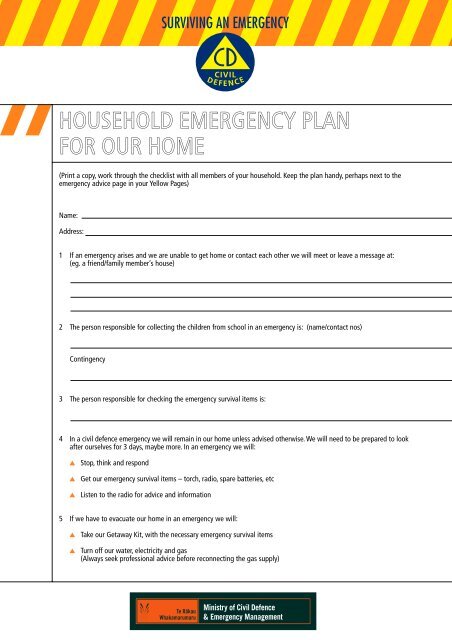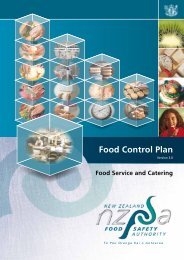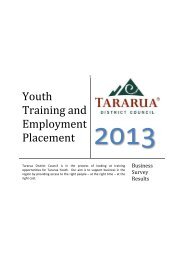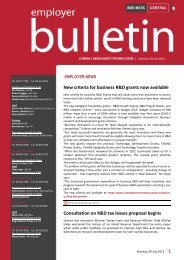HOUSEHOLD EMERGENCY PLAN FOR OUR HOME
HOUSEHOLD EMERGENCY PLAN FOR OUR HOME
HOUSEHOLD EMERGENCY PLAN FOR OUR HOME
You also want an ePaper? Increase the reach of your titles
YUMPU automatically turns print PDFs into web optimized ePapers that Google loves.
SURVIVING AN <strong>EMERGENCY</strong><br />
<strong>HOUSEHOLD</strong> <strong>EMERGENCY</strong> <strong>PLAN</strong><br />
<strong>FOR</strong> <strong>OUR</strong> <strong>HOME</strong><br />
(Print a copy, work through the checklist with all members of your household. Keep the plan handy, perhaps next to the<br />
emergency advice page in your Yellow Pages)<br />
Name:<br />
Address:<br />
1 If an emergency arises and we are unable to get home or contact each other we will meet or leave a message at:<br />
(eg. a friend/family member’s house)<br />
2 The person responsible for collecting the children from school in an emergency is: (name/contact nos)<br />
Contingency<br />
3 The person responsible for checking the emergency survival items is:<br />
4 In a civil defence emergency we will remain in our home unless advised otherwise. We will need to be prepared to look<br />
after ourselves for 3 days, maybe more. In an emergency we will:<br />
Stop, think and respond<br />
Get our emergency survival items – torch, radio, spare batteries, etc<br />
Listen to the radio for advice and information<br />
5 If we have to evacuate our home in an emergency we will:<br />
Take our Getaway Kit, with the necessary emergency survival items<br />
Turn off our water, electricity and gas<br />
(Always seek professional advice before reconnecting the gas supply)
6 Our Neighbours:<br />
Name Address Home /cellphone<br />
Check your neighbours – they may need your help.<br />
A plan of our house showing places to shelter eg in an earthquake, exits, assembly areas and where to turn off water,<br />
electricity and gas:
<strong>HOUSEHOLD</strong> <strong>EMERGENCY</strong> CHECKLIST<br />
Your Getaway Kit<br />
Everyone should have a small bag for a Getaway Kit, ready for evacuation. Most of the items are part of your Emergency<br />
Survival Kit. Other items include:<br />
FAMILY DOCUMENTS<br />
Birth/marriage certificates<br />
Family photos<br />
Drivers’ licences/passports<br />
Insurance policies<br />
PERSONAL HYGIENE ITEMS<br />
Towels/soap & toothbrushes<br />
A change of clothes<br />
Emergency Survival Kit<br />
If you prefer to keep your Emergency Survival Kit items in the house for everyday use, make sure you know where to find<br />
them when an emergency occurs.<br />
FOOD AND WATER – ENOUGH <strong>FOR</strong> 3 DAYS<br />
Canned or dried food<br />
A can opener<br />
A primus or BBQ to cook on<br />
Bottled water (3 litres per person per day)<br />
Check and renew food and water every 12 months.<br />
<strong>EMERGENCY</strong> ITEMS<br />
First Aid Kit and essential medicines<br />
Spare toilet paper and plastic rubbish bags for your emergency toilet<br />
Waterproof torches and spare batteries<br />
Radio and spare batteries<br />
Pet supplies<br />
Check the batteries every three months.<br />
SPECIAL SUPPLIES <strong>FOR</strong> BABIES AND SMALL CHILDREN<br />
Food and drink<br />
Change of clothing<br />
Favourite toy or activity<br />
SPECIAL SUPPLIES <strong>FOR</strong> THOSE WITH DISABILITIES<br />
Glasses<br />
Hearing Aids<br />
Mobility Aids<br />
<strong>EMERGENCY</strong> CLOTHING<br />
Wind proof and rain proof<br />
Sun hats<br />
Strong shoes for outdoors<br />
Blankets or sleeping bags<br />
Put all items, especially blankets and clothing, into leakproof plastic bags.







